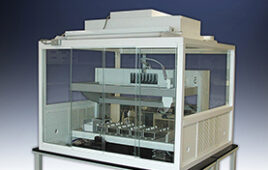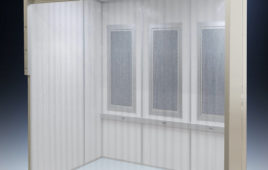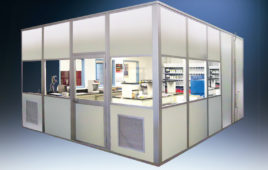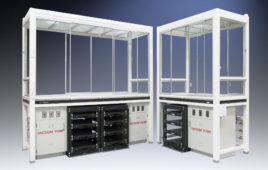Particles on your critical components can impact performance of the final product or the next step in the build process. The goal must be to minimize particulates. Monitoring for particles is important but may not uncover the root causes. Taking a detective approach and thoroughly investigating the “crime” scene can uncover particle sources you may not have thought of (see diagram) and either solve recurrent production problems or head-off problems before they start.

PROCESS ENVIRONMENT
Particles can come from the surrounding environment. This includes the air, personnel, and process chemicals, including water. Cleanroom procedures and maintenance programs are important, but they must be appropriately designed and executed. We see examples of significant particle contamination in what appear initially to be well-maintained cleanrooms and experienced, educated personnel who understood the requirements.
When companies move to a new location, the provenance or history of the room may not be known. In one case, the company inherited a cleanroom from a previous tenant. There were no records of when filters had been installed. Periodic air particle counting and airflow pressure monitoring indicated that particle levels were acceptable for the application. However, the change in ownership and the loss of data made validation and maintenance rather problematic. Even though there were no immediate particle problems, the next recommended step was a thorough and formal inspection of the filters and of the overall cleanroom design.
The problem was solved by using the principle that Toyota Motor Corporation calls Genchi Genbutsu or “go to the source.”1 In another example, a cleanroom appeared to be appropriately designed; gowning and cleanroom protocols were carefully followed. However, periodic high particle count spikes were observed.During a visit to the cleanroom plenum, we determined that air ducts had not been cleaned; gaskets were worn; and the selected filters were, to say the least, not optimal for the performance requirements. Excessive particles had accumulated and were bypassing filters. The filters had been replaced according to schedule, but there was an air route around the filter. Therefore, filter clogging was not detected by pressure monitoring. In addition, in collaborating with the facilities group, we determined that environmental issues and nearby construction probably exacerbated the level of incoming particles. In this case Genchi Genbutsu involved observing the insides of ducts, inspecting filters, and working with personnel closer to the source of the problem.
In areas of poor air quality, HEPA filters may be installed in local schools to protect students and faculty. Air and water pollution can also impact your process. It is important to consider the surrounding environment, the area outside the cleanroom or outside the building. The greater the difference between air quality outside and inside the cleanroom, the greater the chance of contamination entering the cleanroom via personnel or materials that are entering. We have observed processes in areas of poor air quality and recommended filtration of the air entering the entire plant not just for the cleanroom. Placing the full burden on cleanroom filtration leads to higher maintenance costs from more frequent replacement of high cost precision filters.
Particles can be present in water, aqueous blends, solvents, and in other process chemicals. Monitoring and certification can be helpful. However, point of use filtration or in-process filtration may be a more practical solution.
Removal of particles is always a challenge. Some precision cleaning applications use a combination of filtration and liquid particle monitoring. That is, water or an organic solvent is cycled through the rinse chamber and through a filtration system. An in-line liquid particle counter continuously monitors the process. The component is considered to be clean when the particle level drops to a pre-determined level. There are potential “gotchas.” One is defining an acceptable particle level. Another is determining if the cleaning and/or rinsing agents are appropriate to remove particles; this is a sticky problem in that both physical and chemical forces may contribute to particle adherence. The method of applying the cleaning agents can be as important as the chemical properties. Spraying, stirring, or ultrasonic processes may be needed.
PERSONNEL PRACTICES
Proper gowning and gowning procedures reduce, but do not eliminate person-generated particles. We have observed gowning procedures where, rather than gloves used only for the gowning itself and then replaced by clean gloves at the end, the gowning gloves are omitted. Particles from bare hands and face during gowning may deposit on the cleanroom attire and subsequently transfer to the cleanroom gloves. The particles can then be transmitted to the product during normal handling. Since the particles are not airborne, they would not be detected by air monitors.
In spite of personnel training, we have observed uses of face cosmetics. In another case, the product was observed to be contaminated by colorful fibers. These were finally traced to a fuzzy Christmas present sweater being worn under the bunnysuit. We recommend that employee training include education on the impact of ignoring or short-cutting etiquette rules. When employees know WHY it is necessary to do something, not just HOW, they are more likely to adhere to the procedures or even to suggest workable improvements in them.
BUILD OR ASSEMBLY PROCESS
The build and assembly processes themselves can be responsible for particles. We consistently state that a cleanroom does not clean an already contaminated product. Processes prior to or during the transfer into the cleanroom can contribute to particles on the final product. Particles from air or water can be deposited on your product by supplier processes or your own pre-cleanroom processes, including the use of tap water when a higher quality water could prevent the problem.
We have seen a number of instances where incoming product from suppliers in the supply chain contained particle contamination. In one case this was traced to a polishing process using leather straps. This left flakes of leather not only on the surface but also embedded into the surface, making them difficult to remove and requiring a complex cleaning process by the final assembler.
It is quite possible to “shoot yourself in the foot” and recontaminate an already clean component. In recent columns, we discussed the consequences of contamination during transfer of product into and out of the cleanroom.2 In particular was the case of contamination of cleaned parts from lubricants and embedded particles associated with the transfer conveyor.
A key process that impacts particle contamination is drying. Another recontamination issue occurred when parts emerging from the cleaning system were dried on a rack with an air blower. This rack was in close proximity to another with parts that had passed cleaning inspection. Particles from an inadequately cleaned component batch blew off from the drying rack and recontaminated the certified ready-to-ship parts. Containment of the drying area prevents this source of contamination.
Inadvertent drying between a washing and rinsing step can cause particles from the wash agent to adhere to the surface. This is exacerbated by a heated wash, since heated parts dry faster and heat can “bake” on contaminants, making them resistant to removal by subsequent cleaning steps. A solution is to use a mister to prevent drying between steps.
The examples presented here represent only a few of the many pathways that can cause unwanted contamination of critical product. The lesson is to be creative in observation, educate yourself, your employees and your suppliers, and to adhere to or improve process procedures.
References
- See “Toyota Production System” terms at toyotageorgetown.com/terms.asp
- B. Kanegsberg and E. Kanegsberg with Kevina O’Donoghue, “Contamination Control In and Out of the Cleanroom,” Controlled Environments Magazine, February and March 2009.
Barbara Kanegsberg and Ed Kanegsberg, “the Cleaning Lady and the Rocket Scientist,” are independent consultants in critical and precision cleaning, surface preparation, and contamination control. They are the editors of The Handbook for Critical Cleaning, CRC Press. Contact them at BFK Solutions LLC., 310-459-3614; [email protected]; www.bfksolutions.com.




